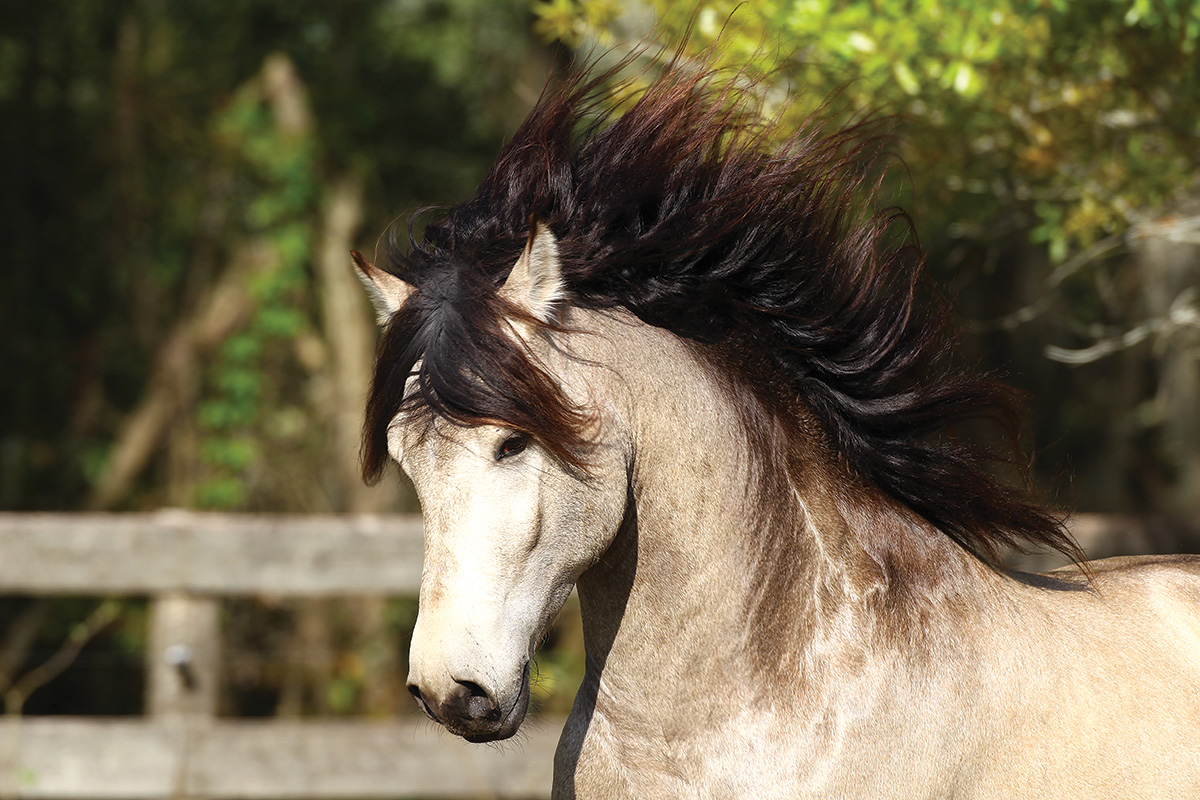If you appreciate sport horses of many different breeding backgrounds, types and colors, the American Warmblood will unite you with like-minded enthusiasts. Read on to learn more about this breed.
After serious health issues forced my mare, Sally, into an early retirement, I began a serious search for a new equine riding partner. As a dedicated Arabian enthusiast, I’d never considered buying a warmblood, but through the days, weeks, and months of searching that ensued, an ad with a photograph stuck with me. The young gelding appeared to be everything I was looking for. The only difference was that he was wrapped in a slightly different package.
With an irresistible face, an athletic build, and a description that included such phrases as “does well in show chaos and remains professional,” “three amazing gaits and remains balanced for a young, growing, horse,” and “funny and personable, loves human attention,” I decided to forego my reservations over the fact that he wasn’t an Arabian and schedule a visit.
After a two-hour trial ride that included trekking across his owner’s property and popping over some fences in her jump field, I was smitten. The deal was made and my first American Warmblood, Bucky, came home with me.
Today, while I still love Arabians, I wonder what took me so long to find this incredible breed. Bucky, who has a Spotted Draft sire and a Quarter Horse dam, is indeed a wonderful representative of the American Warmblood breed. He loves attention, and together we enjoy such activities as jumping, dressage, and trail riding.

Like my horse, the American Warmblood is well-suited for many disciplines, including hunters, jumpers, dressage, eventing, combined driving, western dressage, and working equitation. The versatility that can be found within the breed means that representatives can be found competing at the top levels of many different sports.
A type of horse rather than a specific breed, American Warmbloods are uniquely customized sport horses that are the products of American breeding programs. Multiple acceptable breed crosses can result in a registrable American Warmblood.
A common example is breeding an imported European warmblood stallion (such as Dutch Warmblood, Oldenburg, Hanoverian, et cetera) to an American Thoroughbred mare, but Morgan, American Paint Horse, Appaloosa, Friesian, Tennessee Walking Horse, and draft crosses are examples of other acceptable pairings that reflect breeding flexibility and diversity that might not otherwise be found within the confines of a traditional warmblood registry.

Breed Characteristics of the American Warmblood
Regardless of breeding, one of the most important characteristics of the American Warmblood is having a good temperament that is accommodating and accepting of their often amateur owners’ schedules and abilities.

They can be of any coat color, and their average height ranges from 15 to 17 hands. Correct conformation that can withstand the rigors of sport competition is strongly desired.

By the Numbers
According to Nancy Roth, director of the American Warmblood Society and Sporthorse Registry (AWSSR), approximately 3,000 horses are registered with their organization.
While the number of registered American Warmbloods may seem low when compared to other breed registries, there are estimated to be many more qualifying horses that are unregistered, indicating a healthy interest in the breed.
Registration Eligibility
Roth says that horses are eligible for registration with the AWSSR even if they don’t have a documented pedigree. Applicants will first be issued “performance pending” registration papers that will allow the horse to take part in all registry activities. However, to receive full, official registration papers, horses must complete a performance requirement, she says.
“The performance requirement can be met through placing or earning a minimum score at nationally recognized shows in hunter, jumper, dressage, eventing, hunter breeding, dressage sport horse breeding (DSHB), young horse show series, combined driving, western dressage, and working equitation,” says Roth.

Because western dressage is a new discipline for the registry, scores from schooling shows are also allowed to encourage interest.

Inspections are typically associated with warmblood registries, but with the AWSSR, Roth says that inspection is optional and can be completed at any age. Completing the registration process comes with benefits that include documenting the horse’s existence and enjoying a supportive community of likeminded individuals.
American Warmblood Society & Sporthorse RegistryBased on performance rather than breed type, the American Warmblood Society and Sporthorse Registry (AWSSR) was founded in 1983 and is located in Berger, Mo. The group is a member organization of the United States Dressage Federation (USDF) and participates in its All-Breeds Awards program. The group also offers a stallion service registry for approved stallions, inspection awards, and an ambassador award for American Warmbloods who stand out for a variety of positive reasons on social or regular media. |
Is the American Warmblood Right for You?
If you are looking for a versatile breed prized by amateurs and professionals alike, the American Warmblood is one to watch. This breed stands out as a versatile, athletic, and personable breed that has earned its place in the hearts of sport horse enthusiasts. Whether you’re drawn to their diverse background, their impressive abilities in multiple disciplines, or their friendly, easygoing temperaments, American Warmbloods are well-suited for both amateur and professional riders.
This article about the American Warmblood appeared in the October 2023 issue of Horse Illustrated magazine. Click here to subscribe!





